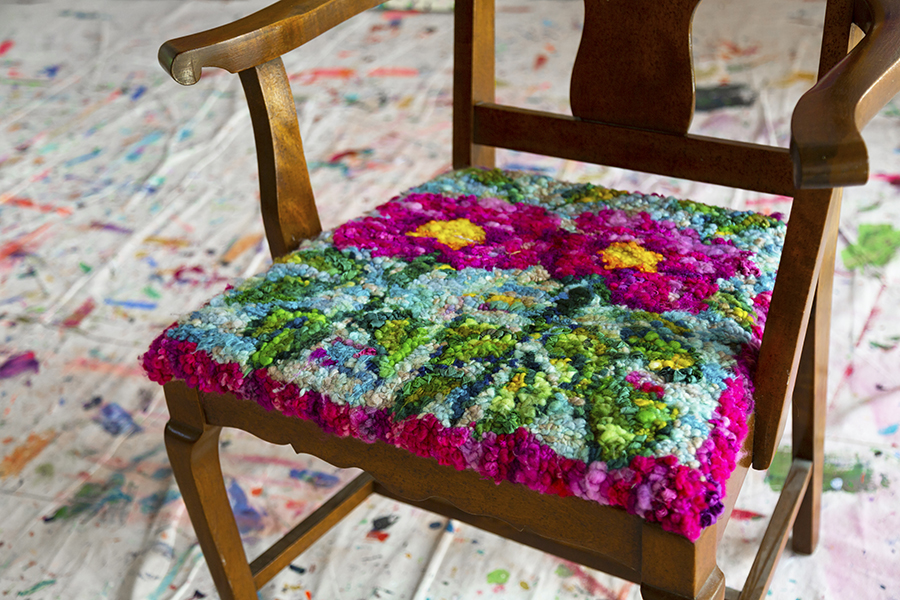Published in Created Here Magazine, issue 09, HERS. Fall 2019.
My grandmother’s big personality was hardly contained by her small stature; she was one of those people who never seemed to age.
When she passed away in 2015 at the age of 104, I came undone. It was unfathomable to me that she would not always be present in my life. I was a grown woman with my own family, but I simply couldn’t imagine life without her.
Around the same time, my mother was diagnosed with Alzheimer’s. The past five years have had countless moments of heartbreak as memories have eroded and been erased. Having a loved one with Alzheimer’s forces you say to goodbye over and over again. It’s this prolonged state of sadness- of heaviness- that becomes part of your everyday.
Essentially, I lost the two most important women in my life at the same time, just in very different ways. I was in a deep grief, and although it was terrifying, I knew I had to experience all of it.
Art has always been an emotional outlet for me. As a painter, I paint quickly, energetically, physically. I need dedicated time and space for concentration and continuity. In paint, I can work quickly through ideas, solving compositions and colour combinations.
In this case, I knew I needed something slow, that would allow me the necessary time to sit with my thoughts and feelings. I made the decision to complete a series of hooked rugs- each it’s own story- based on the incredible life of my grandmother as a way to honour her, and preserve her memory.
I started rug hooking about fifteen years ago; my children were young and frequenting my painting studio was difficult. It wasn’t something that was preconceived or planned at the time. One day I had an immediate and powerful reaction to brilliant colours of yarn, and thought that this was something I could experiment with at home. I chose my ‘palette’ in colours and set to work.
At that time, my painting was focused on the idea of a ‘busy woman’, a woman always rushing to keep up to societal pressures and expectations. This study began as an exploration into self-identity and in time evolved into a playful social commentary, documenting a contemporary woman’s attempt to come to terms with typical female roles. These works were painterly, and abstract, with repeated silhouettes of female figures. During this time, I was experimenting with paint rollers and making handmade stencils. Soon after I realized this imagery would translate effectively into my rug hooking.
My approaches to painting and rug hooking are similar in that I work incrementally, adding areas of colour, building up layers of acrylic paint. I see this as a very female way of working, one which suggests other forms of “women’s work”, such as quilting, knitting or weaving.
My grandmother series, ‘Becoming’, took four years to complete. Paintings began as studies for the hooked rugs, and over time, the hooked rugs also became studies for the paintings.
Rug hooking for me is slow, repetitive, meditative. The hours of labour poured in to the actual construction of these fibre works, mixed with the tactile qualities of pulling and looping the yarn repeatedly, proved to be a therapeutic way to process my grief in an organized way. Working with a uniform size and shape, the completed series of thirty works is displayed in a grid formation, to suggest a story quilt- a quilt that is full of love and tenderness.
Elizabeth Cordelia Morris was born in Wales, in 1910. Her father (a feminist!) believed that girls deserved the same education as boys, and she went to medical school. It was there she met my grandfather, a Canadian, and in 1938 they graduated, married, and moved to Nova Scotia. In 1939, my grandfather left for six years to serve as a surgeon in the Canadian Army overseas. Grandma, left at home with two babies, became the town doctor in Amherst, running her medical practice out of their home. She went on to have six children. At age 60, she rewrote her medical exams to resume her practice, going on to organize and run the Well Woman Clinic, the first of its kind to focus on women’s health in Moncton.
Grandma had a genuine desire for knowledge and her curiosity never faded. She continued to drive her car, get together with girlfriends, play golf, take language and computer courses, volunteer in her community, exercise and stay active, well into her late 90’s.
‘Becoming’ explores the phases of womanhood and examines the powerful force that exists between generations of women, drawing from my own personal family experience. For me, ‘Becoming’ represents joy and sadness, courage and fear, hope and heartbreak. Rooted in Pop-art with a feminist twist, this body of work incorporates traditional rug-hooking techniques with contemporary imagery, offering a modern interpretation through a time-honoured method of women’s cultural production. The interplay of imagery between the paintings and the hooked rugs, results in an affirmative portrayal of love and resilience.
French philosopher, Simone de Beauvoir once stated that, “One is not born, but rather becomes, a woman.” Each individual’s life is composed of stories, moments, and actions. I am immensely grateful to have known my grandmother through so many stages of our lives. Creating this work- exhibiting this work- allows me to continue to share our stories.
Alexandrya Eaton
August 2019


